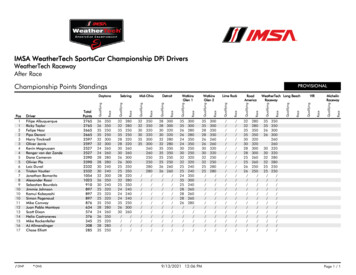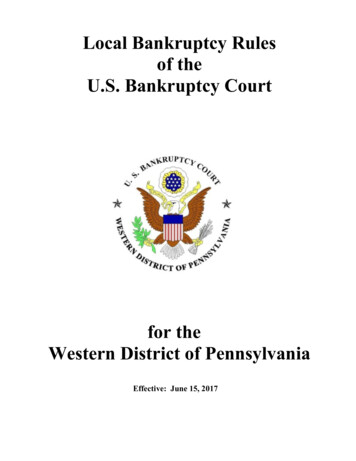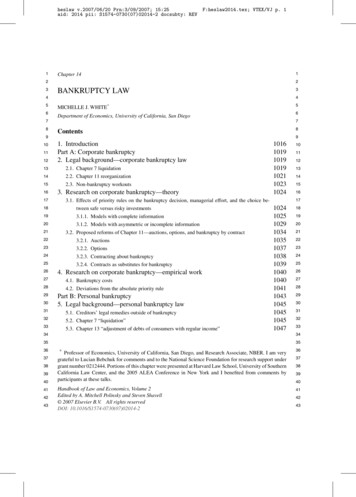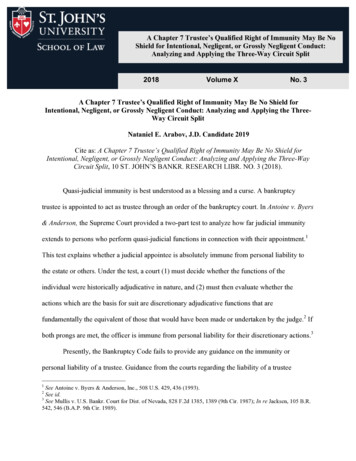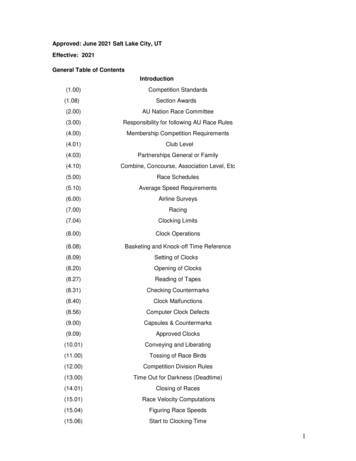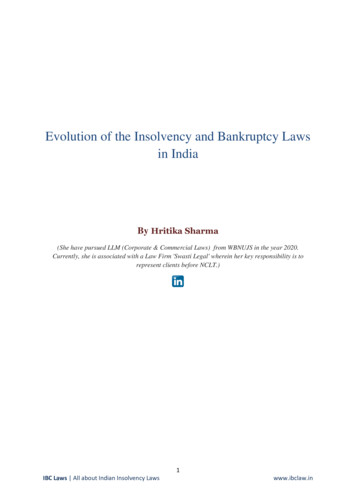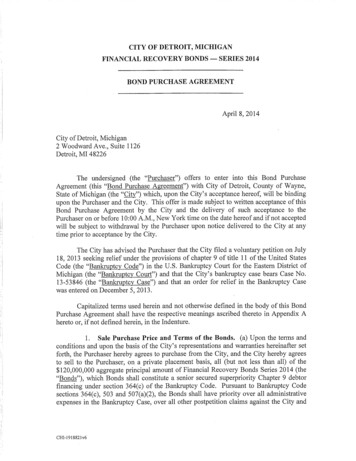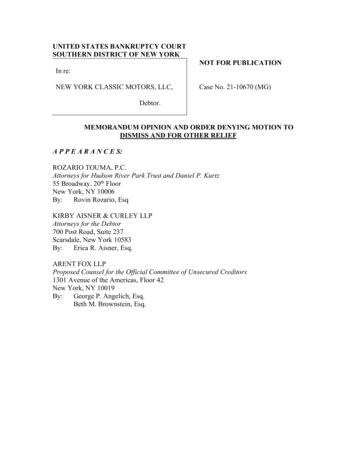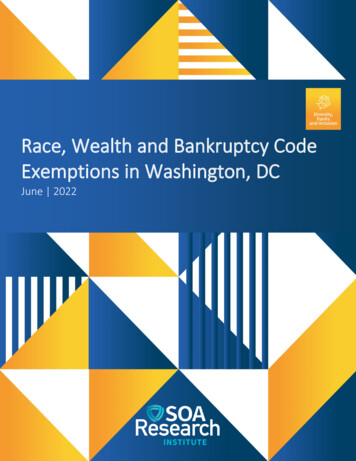
Transcription
Race, Wealth and Bankruptcy CodeExemptions in Washington, DCJune 2022
Race, Wealth and Bankruptcy CodeExemptions in Washington, DCAUTHORSMatthew Adam Bruckner, J.D.Howard UniversitySPONSORDiversity, Equity and Inclusion ResearchAdvisory CouncilRaphaël Charron-Chénier, Ph.D.Arizona State UniversityJevay Grooms, Ph.D.Howard UniversityCaveat and DisclaimerThe opinions expressed and conclusions reached by the authors are their own and do not represent any official position or opinion of the Society ofActuaries Research Institute, the Society of Actuaries or its members. The Society of Actuaries Research Institute makes no representation or warranty tothe accuracy of the information.Copyright 2022 by the Society of Actuaries Research Institute. All rights reserved.
3CONTENTSExecutive Summary . 4Section 1: Introduction . 6Section 2: The Racial Wealth Gap . 7Section 3: Bankruptcy Basics . 8Section 4: Literature Review . 10Section 5: The Dataset. 125.1 Data Entry Work . 125.2 Race Variable . 14Section 6: Data Description. 166.1 Describing the Data . 166.2 Data Limitations . 166.3 Proxy for Race. 176.4 Describing the Data by Race . 19Section 7: Analyses of Property and Exemptions . 217.1 Schedule A: Real Property, Land and Personal Property used as a Residence. 217.1.1 Homestead Values as Reported on Schedule A. 227.1.2 Homestead Exemptions Claimed on Schedule C. 237.2 Personal Property . 247.2.1 Personal Property Values as Reported on Schedule B . 247.2.2 Personal Property Exemptions Claimed on Schedule C . 27Section 8: Conclusion . 31Section 9: Feedback . 32Section 10: Acknowledgments . 33Appendix A: Additional Tables . 34Appendix B: Means and Medians . 36About The Society of Actuaries Research Institute. 37Copyright 2022 Society of Actuaries Research Institute
4Race, Wealth and Bankruptcy CodeExemptions in Washington, DCExecutive SummaryBankruptcy law in the United States is race-neutral on its face. People of all races and ethnicities who file forbankruptcy in a given jurisdiction are subject to the same rules that govern which assets they may retain followingbankruptcy proceedings.However, bankruptcy scholars have theorized that bankruptcy law has racially disparate effects. 1 Our originalresearch provides an empirical look at how facially neutral bankruptcy laws contribute to disparate outcomes forpresumed2 Black or African American3 and white debtors and may therefore play a role in perpetuating wealthinequality across these groups.This report relies on an original dataset compiled from a random sample of bankruptcy filings from 2011 in theUnited States Bankruptcy Court of the District of Columbia. Data from 2011 is the most current year of data readilyavailable to us at no cost, which was an important consideration in our efforts to explore whether we couldsuccessfully complete this analysis. We provide a snapshot of the financial lives of presumed Black and whitebankruptcy filers in Washington, D.C., including their income, expenses and assets at the time they file forbankruptcy. For example, we report that the bulk of debtor’s assets is held in homes, vehicles, retirement accountsand household goods.4 By contrast, insurance products are not a major asset for many debtors.We find that facially race-neutral bankruptcy laws can contribute to racially disparate outcomes in the followingways. First, the Bankruptcy Code provides that every bankruptcy filer may retain all their retirement savings incertain tax-qualified accounts. 5 But the median presumed white filer enters bankruptcy with roughly 25% more1 Mechele Dickerson, Race Matters in Bankruptcy, nt.cgi?article 3711&context mlr. For additionalcitations, see infra note 46.2 Debtors do not report their race or ethnicity when they file bankruptcy. As a result, researchers interested in drawing comparisons based on race orethnicity have had to use a variety of techniques to identify or impute a racial identifier for debtors. As discussed further in Sections 5.2 and 6.2, we use theBayesian Improved Surname Geocoding (BISG) method to impute race and ethnicity. Because of the very small numbers of presumed Asian/AsianAmerican and Hispanic/Latino filers, we limited our analysis to filings of presumed Black and white debtors. The Bayesian Improved Surname Geocoding(BISG) was created by RAND Corporation researchers in 2009 (Elliott et al 2009). More information about this technique and the role it plays in advancingequity in through data can be found on the RAND website. g.html#get-started. Marc N. Elliott, PeterA. Morrison, Allen Fremont, Daniel F. McCaffrey, Philip Pantoja, and Nicole Lurie, Using the Census Bureau’s Surname List to Improve Estimates ofRace/Ethnicity and Associated Disparities, Health Services and Outcomes Research Methodology, June 2009. The Consumer Financial Protection Bureau(2014) also published manual which discussed the method and assesses the usefulness of BISG, entitled “Using publicly available information to proxy forunidentified race and ethnicity.” https://files.consumerfinance.gov/f/201409 cfpb report proxy-methodology.pdf.3 For the sake of brevity, we will use Black in lieu of “Black or African American” for the remainder of the report.4See infra Section 7.2.511 U.S.C. § 522(d)(12) exempts “Retirement funds to the extent that those funds are in a fund or account that is exempt from taxation under section 401,403, 408, 408A, 414, 457, or 501(a) of the Internal Revenue Code of 1986.” Not all states allow debtors to use the federal exemptions. But, relevant for thisreport, the District of Columbia does allow debtors to choose the federal exemptions, and its own exemptions allow a debtor to retain their retirementsavings if they represent “money or other assets payable to a participant or beneficiary from, or an interest of a participant or beneficiary in, a retirementplan qualified under sections 401(a), 403(a), 403(b), 408, 408A, 414(d), or 414(e) of the Internal Revenue Code of 1986, approved October 22, 1986 (100Stat. 2085; 26 U.S.C. § 1 et seq.) (‘1986 Code’), or section 409 (as in effect prior to January 1984) of the Internal Revenue Code of 1954, approved August 6,1954 (68A Stat. 3; 26 U.S. C. § 1 et seq.); provided, that: (A) this paragraph shall not apply to: (i) an alternate payee under a qualified domestic relationsorder, as defined in section 414(p) of the 1986 Code; (ii) a retirement plan, qualified under section 401(a) of the 1986 Code, as a creditor of an individualretirement account qualified under section 408 of the 1986 Code; or (iii) any claims by, or any indebtedness, liability, or obligation owed to, the District ofColumbia; (B) if a contribution to a retirement plan described in this paragraph exceeds the amount deductible or, in the case of a contribution undersection 408A of the 1986 Code, the maximum contribution allowed under the applicable provisions of the 1986 Code, the portion of the contribution thatCopyright 2022 Society of Actuaries Research Institute
5money in their retirement accounts relative to presumed Black filers. As a result, presumed white filers can exemptsubstantially more assets in their retirement accounts ( 13,500) than presumed Black filers ( 6,500). Second,presumed white filers retain far more home equity6 than presumed Black filers. The mean exemption claimed bypresumed white debtors is 198,232, which is substantially larger than that claimed by presumed Black debtors( 105,523). That is, the average presumed Black filer retains 46% less in home equity than presumed white filers.Bankruptcy law is meant to offer a fresh start to honest but unfortunate debtors.7 Home equity and retirementassets are unevenly distributed in our sample across presumed Black and white debtors. Although bankruptcy lawsdo not create the differences in values of presumed Black and white filers’ retirement savings and home values, ouranalysis shows that in Washington, DC, they do nothing to mitigate these differences. This study is limited because itused 11-year-old data from a single jurisdiction. A study across all jurisdictions and across multiple years wouldprovide a more complete review of the social implications of Bankruptcy Code in the U.S.exceeds the amount deductible or, in the case of a contribution under section 408A of the 1986 Code, the maximum contribution allowed, and anyaccrued earnings on such portion, are not exempt” § 15-501(a)(9).6 We will refer to the homestead exemption as pertaining to home equity in several places. This is an oversimplification, but hopefully the aid to clarityoutweighs the costs to accuracy. For a further discussion, see infra note 105.7Marrama v. Citizens Bank of Mass., 127 S.Ct. 1105, 367 (“The principal purpose of the Bankruptcy Code is to grant a ‘fresh start’ to the ‘honest butunfortunate debtor.’”) (quoting Grogan v. Garner, 498 U.S. 279, 286, 287, 111 S.Ct. 654, 112 L.Ed.2d 755 (1991)).Copyright 2022 Society of Actuaries Research Institute
6Section 1: IntroductionAlthough U.S. bankruptcy law is race-neutral on its face, bankruptcy scholars have theorized that it has raciallydisparate effects. 8 For example, the Bankruptcy Code advantages white people because it provides certain benefitsto homeowners that it does not provide to renters, and, nationwide, white people are substantially more likely to behomeowners than other racial or ethnic groups.9 Similarly, bankruptcy law generally advantages people who haveretirement savings in certain qualified accounts10 by allowing debtors to keep their equity in those accounts, and,nationwide, white Americans are more likely to have such accounts than other racial or ethnic groups. 11 As a result,scholars such as Professor Mechele Dickerson at the University of Texas School of Law have argued that theBankruptcy Code favors white debtors over debtors of other races. 12 Before this report, however, no empirical workhad established whether these racial disparities actually exist in bankruptcy, nor had anyone quantified them.13This report provides details of original research quantifying racial disparities in personal bankruptcy cases filed inWashington, D.C., in 2011. In particular, we evaluate some of the first empirical evidence for Professor Dickerson’stheory by looking at the role that exemptions (the method for providing preferential treatment to certain assets inbankruptcy) play in perpetuating or increasing wealth inequality across Black and white Americans. 14 This reportdetails the frequency and value of real and personal property ownership in bankruptcy for residents of Washingtonin 2011. Studied property includes retirement account ownership and the rate of insurance policy ownership.Studied property also includes the ownership rates and value of apparel, jewelry, cash and cash equivalents, otherhousehold goods, vehicles and homes.We offer two primary contributions. First, we examine racial disparities in bankruptcy cases that emerge despite thefacially neutral Bankruptcy Code exemptions. Second, we create a new dataset of bankruptcy data based on arandom sample of petitions drawn from the United States Bankruptcy Court for the District of Columbia, all of whichwere filed in 2011. This dataset will be made available to other researchers in the future.158Mechele Dickerson, Race Matters in Bankruptcy, nt.cgi?article 3711&context mlr. For additionalcitations, see infra note 46.9 Id. (“There is, again, a significant racial disparity in homeownership. However, homeownership rates for whites in 2005 (75%) far exceeded the rates forblacks (less than 49%), Hispanics (less than 50%), Native Americans (58%), and Asians (60%).”)10 11 U.S.C. § 522(d)(12) exempts “Retirement funds to the extent that those funds are in a fund or account that is exempt from taxation under section401, 403, 408, 408A, 414, 457, or 501(a) of the Internal Revenue Code of 1986.” Not all states allow debtors to use the federal exemptions. But, relevantfor this report, the District of Columbia does allow debtors to choose the federal exemptions, and its own exemptions allow a debtor to retain theirretirement savings if they represent “money or other assets payable to a participant or beneficiary from, or an interest of a participant or beneficiary in, aretirement plan qualified under sections 401(a), 403(a), 403(b), 408, 408A, 414(d), or 414(e) of the Internal Revenue Code of 1986, approved October 22,1986 (100 Stat. 2085; 26 U.S.C. § 1 et seq.) (‘1986 Code’), or section 409 (as in effect prior to January 1984) of the Internal Revenue Code of 1954,approved August 6, 1954 (68A Stat. 3; 26 U.S. C. § 1 et seq.); provided, that: (A) this paragraph shall not apply to: (i) an alternate payee under a qualifieddomestic relations order, as defined in section 414(p) of the 1986 Code; (ii) a retirement plan, qualified under section 401(a) of the 1986 Code, as acreditor of an individual retirement account qualified under section 408 of the 1986 Code; or (iii) any claims by, or any indebtedness, liability, or obligationowed to, the District of Columbia; (B) if a contribution to a retirement plan described in this paragraph exceeds the amount deductible or, in the case of acontribution under section 408A of the 1986 Code, the maximum contribution allowed under the applicable provisions of the 1986 Code, the portion ofthe contribution that exceeds the amount deductible or, in the case of a contribution under section 408A of the 1986 Code, the maximum contributionallowed, and any accrued earnings on such portion, are not exempt” § 15-501(a)(9).11Mechele Dickerson, Race Matters in Bankruptcy, nt.cgi?article 3711&context mlr (“it is notsurprising that minorities have smaller amounts and values of tax-deferred retirement accounts”).12 Professor Dickerson has argued that bankruptcy law favors certain white debtors over other racial groups by, among other things, allowing debtors toretain their equity in assets that white debtors are more likely to own. Id. (reviewing the types of assets given preferential treatment in bankruptcy and theprevalence of these assets held by various racial groups outside of bankruptcy).13 At least one paper has quantified the percentage of filers with retirement accounts and the value of those accounts, but the authors do not separate outthose numbers by the race or ethnicity of the person who holds those accounts. Pamela Foohey, Robert M. Lawless & Deborah Thorne, Portraits ofBankruptcy Filers, 56 Ga. L. Rev., Forthcoming 2022, https://papers.ssrn.com/sol3/papers.cfm?abstract id 3807592 (providing evidence of the rates ofretirement account ownership by debtors and the value of those accounts).14We limited our analysis to filings of presumed Black and white debtors because of the very small numbers of presumed Asian/Asian American andHispanic and Latino filers in our sample.15 Interested researchers should contact any of the report’s authors.Copyright 2022 Society of Actuaries Research Institute
7Section 2: The Racial Wealth GapThis report explores wealth differences between presumed Black and white Washingtonians who filed forbankruptcy in the District of Columbia in 2011. A racial wealth gap exists in America, with typical white familiesholding eight times more wealth than typical Black families and five times more than typical Hispanic families. 16According to data from the 2019 Survey of Consumer Finances, the median white household in America had a nethousehold wealth ( 188,200) that was approximately eight times greater than the median Black household( 24,100).Although we hope this report informs conversations about racial wealth inequality across America, our empiricalestimates are obtained from documents filed in Washington, D.C., in 2011. In Washington around that time, thewealth gap between Black and white households appears to be greater than the national wealth divide. The UrbanInstitute reports that in 2013–14, white households in the District of Columbia had a net worth more than 80 timesgreater than the typical Black household.17 In other words, the racial wealth gap appears to be almost 10 timeslarger in the district than the national wealth gap. The Urban Institute also reports that Black families own homesthat are valued “significantly lower” than those owned by white families. 18 Similar results were found in other assetcategories as well, with white families being more likely to have liquid assets,19 checking accounts,20 other financialassets, such as stocks, bonds and mutual funds,21 vehicles 22 and retirement funds.23 White “households had thehighest median value of liquid assets,” at 65,000. “The median value was only 5,000 for U.S. Black households[and] 2,100 for African Black households.”24Black Washingtonians have “higher homeownership rates than Black Americans living elsewhere. Whites alsohave higher homeownership rates, but the difference from Whites nationally is smaller.”25 In other words, althoughwhite Washingtonians are more likely to own homes than Black Washingtonians, the racial homeownership gap issmaller in the district than it is nationally. 26 This is important because home ownership has traditionally been animportant path to wealth building in this country and has, therefore, been an important component of the racialwealth gap. 8.htm (defining wealth as “the difference between families’ gross assets and their liabilities”).17“[T]he typical White household in D.C. had a net worth of 284,000. Black American households, in contrast, had a net worth of n-the-nations-capital 8.pdf.18 “The typical home value for Black households in D.C. is 250,000, about two-thirds of the home value for White and Latino households.” Id.19 “Nearly all White households in Washington, D.C. (97.0 percent), possessed liquid assets (table 3). U.S. Black (79.2 percent), African Black (78.5percent), and Latino (86.0 percent) households had lower shares of liquid asset ownership.” Id. at 47.20 “Fewer U.S. Black households (67.7 percent) owned checking accounts than White households (91.8 percent). African Black and Latino households werealso less likely than Whites to have checking accounts. However, the differences were not statistically significant.” Id.21 “All non-White groups in the NASCC sample reported lower shares of households that own other financial assets, such as stocks, bonds, and mutualfunds.” Id. (“While 52.8 percent of White households owned stocks, only 18.6 percent of U.S. Black, 14.6 percent of African Black.”)22Id. at 54 (“Car ownership was high among all groups in Washington, DC.U.S. Black households had the lowest rate of car ownership (78.0 percent) whileall other groups had car ownership rates above 90 percent.”).23 “For most groups in the District, the share of households owning individual retirement accounts or private annuities was larger than the share owningstocks. White (64.2 percent), households had the highest ownership rates. U.S. Black households (26.4 percent), African Black households (28.6percent) . had significantly lower rates of ownership than other groups.” Id. at 48.24 Id. at 55.25 Id. (capitalization of white was in the original text).26 Id. at 51–52 (“Homeownership rates vary widely by race and ethnicity in Washington, DC. Seventy-eight percent of White households owned theirhomes. Black and Latino households had the lowest homeownership rates. Only 58.4 percent of U.S. Black, 46.1 percent of African Black, and 49.7percent of Latino households reported owning a home.”27 See infra Section 7.1 (discussing our findings about home ownership rates by race in our data).Copyright 2022 Society of Actuaries Research Institute
8Section 3: Bankruptcy BasicsHundreds of thousands of people file for bankruptcy in the United States every year.28 Many more would likelybenefit from bankruptcy by discharging their debts while retaining their assets but do not file for various reasons. 29In particular, Professor Dickerson suggests that there are good reasons to believe that white Americans are morelikely to benefit from bankruptcy than Black Americans. 30 Nevertheless, researchers have repeatedly found thatBlack Americans are more likely to use bankruptcy.31The Bankruptcy Code provides two primary options for individuals who seek debt relief: chapter 7 and chapter 13.Historically, chapter 7 is favored by approximately two-thirds of consumer debtors. 32 The “deal” in chapter 7 is thata person may keep all their future income but must give up many of their current assets.33 By contrast, the deal inchapter 13 generally allows a person to keep most of their current assets but they must give up all their disposableincome for three to five years.34 Whichever chapter a person chooses, they initiate their bankruptcy case by filing apetition with the bankruptcy court.Filing a petition creates the so-called “bankruptcy estate,” which comprises all the debtor’s assets when they initiatetheir case. All the debtors’ assets, including their retirement accounts, insurance policies, cars, houses, jewelry,clothing and furniture, become part of the pool of assets that may be used to satisfy their creditors. They arerequired to list all their assets on a form called a schedule. 35 In a chapter 7 bankruptcy, these assets are often sold,and the proceeds are distributed to creditors in partial satisfaction of the debts the debtor owes them.But not all of a debtor’s assets must be sold. Whether they file under chapter 7 or chapter 13, debtors may keepsome amount of their property, referred to as an exemption.36 In some states and the District of Columbia, debtorsmay choose between federal exemptions and state or district exemptions. In the District of Columbia, debtors mayexempt all the equity in their homes. By contrast, current federal law allows a debtor to retain only approximately28Pamela Foohey, Robert M. Lawless & Deborah Thorne, Portraits of Bankruptcy Filers, 56 Ga. L. Rev., Forthcoming act id 3807592 (“In the past decade alone, from 2009 to 2018, over 11 million individuals filedbankruptcy.”).29 Michelle White, Why Don’t More Households File for Bankruptcy?, 14 J. L. Econ & Org. 205 (1998), https://econweb.ucsd.edu/ miwhite/white-jleoreprint.pdf (claiming that “A much higher fraction of U.S. households would benefit financially from bankruptcy than actually file. While the currentbankruptcy filing rate is about 1% of households each year, I calculate that at least 15% of households would benefit financially from filing and the actualfigure would be several times higher if most households plan in advance for the possibility of filing.” The author also discusses two reasons for “missing”bankruptcy filings, including when creditors do not take legal action against debtors (who then “get the benefit of default without bearing the cost of abankruptcy filing[],” and the option value of a future bankruptcy filing.).30Mechele Dickerson, Race Matters in Bankruptcy, nt.cgi?article 3711&context mlr (“After examiningcensus and other empirical data, I concluded that the Ideal Debtor is white and, for that reason, race mattered in bankruptcy.”); see also Pamela Foohey,Robert M. Lawless & Deborah Thorne, Portraits of Bankruptcy Filers, 56 Ga. L. Rev., Forthcoming act id 3807592 (identifying three themes among bankruptcy filers, including (1) some people file becausethey can capture the financial benefits of bankruptcy; (2) others file because bankruptcy offers certain protections from lawsuits, such as the automaticstay; and, finally, (3) still others file because they have unsustainable debts).31 “Black Americans are overrepresented among bankruptcy filers.” Alicia Louise Duncombe, Race and the Educational Disparities in Midlife BankruptcyFilings, M.A. Thesis (2020), le/2152/87144/DUNCOMBE-THESIS-2020.pdf?sequence 1&isAllowed y;Pamela Foohey, Robert M. Lawless & Deborah Thorne, Portraits of Bankruptcy Filers, 56 Ga. L. Rev., Forthcoming act id 3807592 (“Black households file bankruptcy at more than twice the rate they appear in the generalpopulation.”).32Pamela Foohey, Robert M. Lawless & Deborah Thorne, Portraits of Bankruptcy Filers, 56 Ga. L. Rev., Forthcoming act id 3807592.33 Robert M. Lawless & Angela Littwin, Local Legal Culture from R2D2 to Big Data, 96 Tex. L. Rev. 1333 (2018) (“Under chapter 7, debtors liquidate all oftheir nonexempt property and receive a discharge of most unsecured debts.”).34 Id. (“chapter 13 requires debtors to pay all of their disposable income over a period of three to five years [and] does provide tools for some consumerstrying to save their homes and a broader discharge than chapter 7.”).35 Debtors list all of their legal and equitable interests in a residence, building, land or similar property (including burial plots) on schedule A. Personalproperty is listed on schedule B. These forms are available at schedule-ab-property-individuals.36For this reason, we do not separately analyze chapter 7 and chapter 13 petitions. See also Pamela Foohey, Robert M. Lawless & Deborah Thorne,Portraits of Bankruptcy Filers, 56 Ga. L. Rev., Forthcoming 2021, https://papers.ssrn.com/sol3/papers.cfm?abstract id 3807592 (“The debtor can exemptspecific assets from their bankruptcy estate. The chapter 7 trustee sells nonexempt assets in the estate and distributes the proceeds to creditors.”).Copyright 2022 Society of Actuaries Research Institute
9 25,000 in home equity. 37 All exemption laws limit the amount of property a debtor may retain on a category-bycategory basis. In other words, a person claiming the federal exemptions in 2021 may retain up to 25,150 in homeequity and up to 4,000 in one vehicle. They may not, however, retain 29,000 in home equity and give up theirvehicle.Several reasons can be identified to allow debtors to keep some amount of their property even though they owetheir creditors more than they can repay. First, some assets are worth far more to the debtor than they are to thecreditor. For example, family photographs normally have sentimental value to the debtor but would not fetch muchif they were sold. Second, if creditors were allowed to seize
order, as defined in section 414(p) of the 1986 Code; (ii) a retirement plan, qualified under section 401(a) of the 1986 Code, as a creditor of an individual retirement account qualified under section 408 of the 1986 Code; or (iii) any claims by, or any indebtedness, liability, or obligation owed to, the District of

